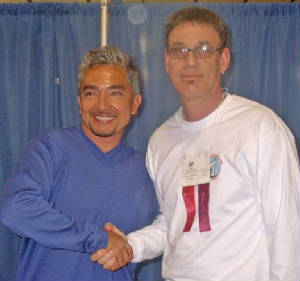By Marc Goldberg, CDT
© 2009 Marc Goldberg. All rights reserved.
There are a variety of collars, you can use for your dog. Each color type has its own advantages and disadvantages. Choosing the right dog training collar depends on your dog's temperament, and the job you are trying to do. Collars belong to two different categories: static or dynamic. Static collars or buckle collars are dog collars that remain fixed in diameter on the dog's neck. These are the collars you would typically keep your dog tags on. They may be used on a leash or for a temporary tie out, but are not very useful for most training purposes. Dynamic collars are collars whose diameter changes when pressure is applied. The most common example of a dynamic collar is the so-called choke chain.
In nearly all instances, a dynamic collar is preferred to a static collar while training your dog because a dynamic collar actually puts less stress on your dog's trachea than a static collar. This is because of the way the force is distributed around the dog's neck. Instead of being absorbed entirely in the trachea, pressure is spread out.
“Choke chain.” The most common type of dynamic training collar is commonly referred to as a choke chain. It may also be called a slip collar or a slip chain. The slip chain is a common tool and is widely used and has been for many years. One of the reasons it is so popular is that it is relatively cheap and simple to use. This collar however, does not give a tremendous mechanical advantage, and therefore may not be the best choice for a large unruly dog. Also, used incorrectly by the average dog owner, the choke chain can turn into a strangle collar, unpleasant for both dog and owner.
Martingale collar. A less common form of dynamic collar is what is referred to as a martingale collar or a limited slip choke chain. These collars are generally made of nylon with a chain loop linking the two ends of the nylon. The leash is attached to the chain loop and when pulled it tightens the nylon around the dog's neck. This collar gives even less of a mechanical advantage than the choke chain, and it can be difficult to fit properly. The advantage to this collar, is that there is a definite limit to how much pressure, you can put on the dog's trachea because the collar can only close to the specific diameter and no smaller. So, fitted correctly, this may be a good choice for giving a mild correction without choking the dog.
Pinch collar. For large and unruly dogs it is often a possible to go with a prong or pinch collar. There are two types of pinch collars that are popular today. The most common is the metal prong collar. These dog training collars have been around for a long time and are fairly readily available in pet stores everywhere. They offer a significant mechanical advantage, however, they can be difficult put on especially if you have weak or arthritic hands. Also, even though they are humane, they look like they are quite cruel, and can create a negative public perception. Finally, they are much more expensive than both the choke chain or the martingale. Proper use of the pinch collar never involves jerking the leash and hurting the dog. Think of this collar as providing power steering. A very small adjustment goes a long way. In short, the pinch collar—when used properly—can help you train your dog with no discomfort whatsoever. If you can’t make it work, a good dog trainer can show you in moments.
Good Dog Collar. Another form of prong collar is the Good Dog collar. The Good Dog collar is essentially a plastic prong collar. It provides much of the same mechanical advantage of the traditional metal prong, but it is easier to put on the dog, and it looks less intimidating. The only disadvantages of this collar is that they can be hard to find and you have to get used to snapping it together or apart when putting it on or off.
There is no such thing as the perfect dog training collar. Ultimately, the right collar for you is the collar that works for your dog.





